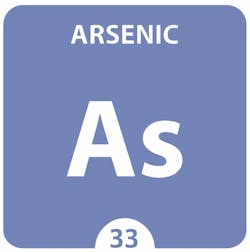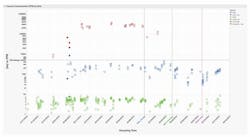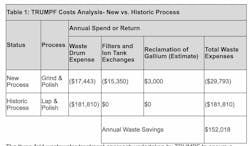Arsenic & Lasers
David Troy is sustaining engineering manager for Trumpf Photonics. Vladimir Dozortsev is development manager of trace metal instrumentation for Aqua Metrology Systems. Troy can be reached at [email protected] or 609.564.0214. Dozortsev can be reached at [email protected] or 408.306.4086.
undefinedBased in Princeton, N.J., Trumpf Photonics Inc., (Trumpf) is a manufacturer of laser diodes made from gallium arsenide substrates (GaAs) wafers. The GaAs wafers must be thinned a4s part of the product requirements, a process that allows arsenic to dissolve into the wastewater stream creating hazardous waste that must be treated prior to discharge.
In 2019, Trumpf implemented a new wafer thinning process to move away from lapping, a low capability process, as compared to grinding, a high capability process. Deionized water (DI) is used in the grinding operation to serve as a lubricant and as a carrier vehicle for the grinding wheel to pull the gallium arsenide particles away from the grinding wheel and into the waste stream. While both lapping and grinding create a wafer with a thinness of 110 um while generating 1 to 2 kg of GaAs waste per week, the grinding process creates 30 times more hazardous wastewater by volume than the lapping process requiring treatment.
The lapping process generated 12 55-gal drums of wastewater per week with associated treatment costs averaging $185,000 per year while the grinding process was predicted to produce 346 55-gal drums a week at an estimated cost of $5 million per year to treat. This represented a severe logistical constraint for Trumpf because the facility cannot accommodate that large amount of waste. This became a point of concern for Trumpf because its goal was to develop a practical and cost-effective wafer-thinning wastewater treatment process to support the new high-capability grinding process.
Wastewater Treatment Approach
To ensure a cost-effective wastewater treatment solution for its new wafer thinning technology and high-capability grinding process, Trumpf undertook a threefold treatment approach. This approach included removing particles through cartridge filtration; removing the dissolved ionic arsenic through ion exchange (IEX); containing, measuring and reducing trace arsenic particle amounts in wastewater; and releasing compliant wastewater to the city sewer.
Following a third-party engineering report to determine a suitable IEX treatment method, Trumpf implemented a multi-stage treatment approach, including 1- and 5-μ cartridge filtration (CF) to remove GaAs particulates, followed by an IEX filtration system composed of one carbon filter for organic removal and two arsenic resin tanks and two mixed-bed resin tanks to remove dissolved ionic (free) arsenic.
Trumpf must meet a regulatory requirement of 500 ppb or less of arsenic to be discharged to the local municipal treatment facility. However, the wafer-thinning process generates untreated influent wastewater with arsenic levels of 42.1 ppm.
To ensure compliance of the process wastewater so that it can be safely discharged, Trumpf needed to attain reliable and continuous measurements of arsenic concentrations in its wastewater. As a result, Trumpf selected the online arsenic monitor, MetalGuard Arsenic, manufactured by Aqua Metrology Systems, which uses anodic stripping voltammetry (AVS) technology to measure arsenic concentrations in real time.
The installation of the online arsenic analyzer was completed in the winter of 2018, and it supports the entire treatment process at Trumpf by providing continuous and reliable data on real-time arsenic levels at various stages, including untreated/post cartridge filters, partially treated post arsenic resin tank 1 and fully treated post arsenic resin tanks 1 and 2 (Figure 1). The fully treated waste stream is measured at the storage tote continuously while the untreated and partially treated samples are pulled manually and introduced to the online arsenic analyzer using the grab port. The analyzer provides high-frequency real-time data on arsenic levels in less than 30 minutes with a sensitivity down to 1 ppb.
Measuring Arsenic Levels in Real-Time
The electroanalytical method of ASV is a concept that is well suited to provide unattended automated trace metal analysis field units. It has high sensitivity and selectivity to arsenic species. The ASV measurement process involves two major stages: sample preparation and voltammetric measurement.
During the sample preparation stage, the sample undergoes a reduction process during which all dissolved arsenic species are converted into the measurable arsenite form. Further, the pre-treated sample is taken into a measurement detector where resulted arsenic (arsenite) is analyzed as total arsenic using a proprietary voltammetric detector with self-regenerated probe.
ASV measurement involves two sequential steps; arsenic accumulation and stripping. During the accumulation step, an arsenite specie is electroplated onto a working electrode surface as elemental arsenic to increase probe sensitivity. During the second step, stripping, the accumulated arsenic is oxidized and stripped from probe surface during anodic scan. The voltammetric signal is proportional to analyte concentration in the solution and can be calibrated (Figure 2).
This analytical approach employs a sensor self-generation mechanism that makes the probe less susceptible to gradual contamination from impurities or byproducts from the electrochemical process. As a result, the detector is capable of maintaining its sensitivity and calibrated status for an unlimited time frame while operating reliably regardless of sample matrix conditions.
The monitor ensures sample stability compared to manual sample preparation and analysis that carries a high risk of inconsistency and human error. As a fully automated technology, the entire sample preparation and measurement processes provides a high accuracy and repeatability of the measurements and ensures lowest detection limits, selectivity down to 1 ppb total arsenic species. Also, flexible sample preparation routine allows speciation of different arsenic forms such as As(III), As(V) and total As. The system also allows for manually collected samples to be analyzed via a grab port.
Software controls the entire measurement process and allows process operators to access valuable data in near real-time manner. Thousands of continuous measurements can be performed in unattended manner by an online arsenic analyzer without any operator interference.
The Value of Real-Time Arsenic Data to Trumpf
The analyzer continuously measures influent and effluent arsenic levels in real-time, providing Trumpf with a stream of accurate and reliable arsenic data to measure the performance of its IEX system and ensure regulatory compliance. The data from the online arsenic analyzer was in agreement with external lab results and provided Trumpf with a high degree of confidence. (Looking at the data collectively, open circles are representative of data from the online arsenic analyzer, and the closed diamonds are from an external lab. Red data points are from manually sampled wastewater that was filtered but untreated. Blue data points are from manually sampled wastewater from the first arsenic resin tank (ASG-1) that was filtered and partially treated. Green data points are from manually sampled wastewater from the second arsenic resin tank (ASG-2) that was filtered and completely treated. All of the partially treated samples (blue) and completely treated samples (green) scored below the arsenic discharge limit of 500 ppb. While partial treatment could have tighter distribution, all of the online arsenic monitoring data falls between the external lab values providing Trumpf with confidence in the monitoring accuracy of the analyzer. All fully treated samples, post ASG-2, had values below 10 ppb (1.5 orders of magnitude below the discharge limit), enabling Trumpf to release wastewater into the city sewer.
The implementation of the online arsenic monitoring system to sample, measure and analyze data in real-time internally saved both time and money for the facility.
The high frequency of arsenic data enabled Trumpf to operate its IEX to treat actual arsenic levels, not dated values produced from standard analytical methods that can take up to two weeks to produce results. With the online arsenic analyzer, Trumpf obtained measurement results in 30 minutes to better understand the effect of the different treatment stages on arsenic within the wastewater management system.
With the high frequency of data, Trumpf was able to trend results at multiple stages in the wastewater remediation system to identify patterns and develop learning opportunities. The timely and accurate arsenic results enabled Trumpf to optimize rinse water reuse as well as reduce IEX backwash frequencies, increasing media performance and reducing hazardous waste generation. The online analyzer also afforded Trumpf the flexibility to monitor performance of the wastewater remediation system while the grinder is running product or in stand-by. The real-time arsenic data eliminated the need to store treated wastewater until lab results were returned and confirmed regulatory compliance.
With a reliable method to continuously measure performance of the arsenic remediation system in real time, Trumpf was able to move to a closed-looped system within months. The high frequency of accurate and reliable results from the online arsenic analyzer gave Trumpf the confidence to recirculate the treated water back to the grinder as the DI source input reducing its water consumption by 90%. By treating and recirculating the wastewater, the overall DI water consumption of the grinding process was reduced to a lower level than the lapping process. All combined, this allowed Trumpf to not only minimize costs but ensure that it operates in a greener, more sustainability-focused and environmentally responsible manner.
The threefold wastewater treatment approach undertaken by Trumpf to ensure a cost-effective solution for its new wafer thinning technology and high-capability grinding process has resulted in process improvements that have provided an estimated annual cost savings of approximately $150,000 with a return on investment of less than one year (Figure 4). The closed-loop system design leaves open the opportunity to possibly reclaim the gallium from the GaAs left in the particle filters, which would bring Trumpf an additional estimated $3,000 annually.
Conclusions
The use of the online MetalGuard arsenic analyzer provided confidence and the ability to create trend data to evaluate the effectiveness of the waste treatment system as it was being used and refined.
The arsenic abatement system was converted to a closed loop system, which resulted in 90% effective water conservation system over the open loop system. The use of the online arsenic analyzer and IEX systems delivered process knowledge and cost savings of more than $150,000 compared with the prior drum and contain system.




